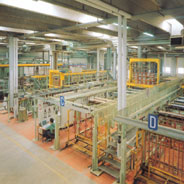




PROCESSES
 |
 |
 |
 |
 |
|||
| SUGGESTIONS | CATALOGUE | MATERIALS
& PROCESSES |
COMPANY | NEWS | CONTACTS | ||
|
|
|
ZINC PLATING |
|||||||||||||
 |
GENERAL DESCRIPTION OF TREATMENT The electrolytic galvanizing process aims at creating a coating of zinc able to ensure resistance to atmospheric corrosion, according to the thickness of the coating. Electrolytic zinc coatings can be improved in terms of appearance and protective power by means of a final passivation treatment. |
|||||||||||||
|
|
||||||||||||||
| COATING DISTRIBUTION AND CHARACTERISTICS | The electro-deposited zinc layer, like all electrolytic coatings, is not uniformly distributed, even though special additives added to the galvanizing bath obtain good distribution characteristics and leveling of the coating, but deposition in holes or undercuts remains difficult and at times impossible. The deposition can be made by frame or tumbler depending on the characteristics of the article and client requirements. | |||||||||||||
| REACTION TO CORROSION | Zinc coatings feature optimal reaction to corrosion; just a few microns are enough for adequate protection against atmospheric corrosion. Obviously, depending on the conditions and place of use, the coating thickness may need to be increased, with possible post-treatments known as chromating or passivation, which guarantee both improved appearance and increased resistance to corrosion. Usually, depending on the thickness and conditions of use, iridescent passivation guarantees greater resistance to corrosion with respect to blue passivation. |
|||||||||||||
| FINISHES |
The following table illustrates the types of finishes (passivations) currently possible
|
|||||||||||||
|
COMPATIBLE MATERIALS |
Bettini can currently apply zinc coatings on all types of iron and steel with the exception of cast irons and high speed steels (HSS) | |||||||||||||
| HEAT TREATMENTS AFTER ZINC-PLATING |
Zinc deposits can contain quantities of hydrogen, which are generated during deposition, which may, especially in the case of heat treated steels, give rise to problems of embrittlement for both the coating and metal substrate. Hydrogen can be partially eliminated by heating the part at around 180° C for three hours. |
|||||||||||||
| DIMENSIONAL CONSTRAINTS | Bettini can currently zinc plate parts with the maximum dimensions specified below: length = 1100 mm height = 600 mm weight = 300 kg |